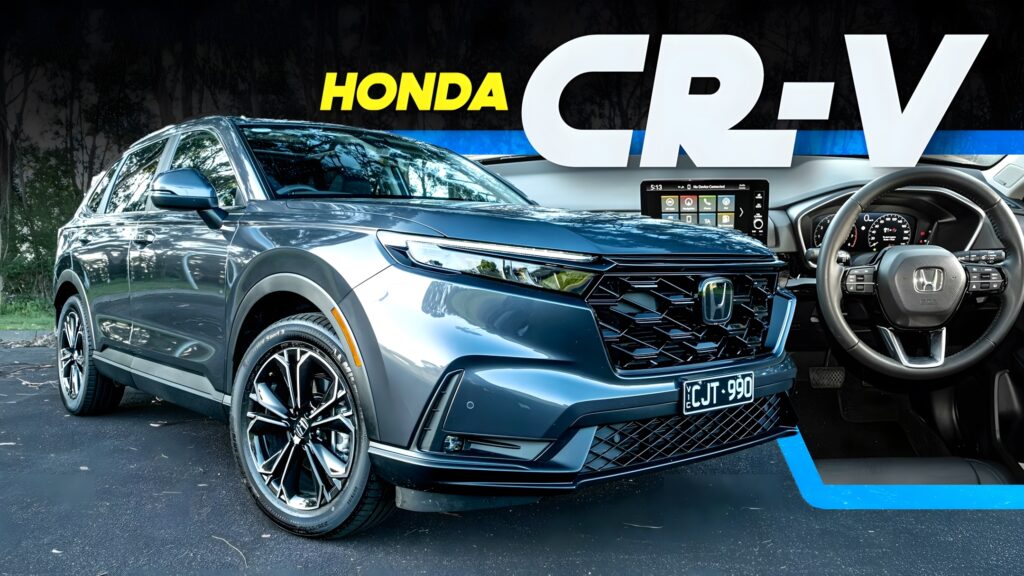
The CR-V is well worth considering for anyone in the market for a new SUV
5 hours ago
PROS ›› Elegant styling, simple but well-made and spacious cabin, refined and comfortable ride, more than adequate performance CONS ›› Lack of off-road modes, small infotainment screen with rather basic menus, not the most inspiring drive in its class
The CR-V has been a cornerstone of Honda’s lineup since its 1995 debut, and now, in its sixth generation, it remains one of the most recognizable players in the fiercely competitive compact SUV market. It holds its ground not only against stalwarts like the Toyota RAV4, Subaru Forester, and Volkswagen Tiguan but also faces fresh challengers such as the Ford Bronco Sport, all competing to capture the attention of an increasingly demanding audience,
The latest model—much like its predecessors—manages to stand apart from its rivals with a design that’s distinct yet unmistakably Honda. Adding to its appeal, the CR-V is offered in a wide range of specifications, particularly in Australia, where buyers can choose from no fewer than seven variants. Among them is a standout hybrid option, equipped with the same ultra-efficient powertrain found in other Honda models, such as the Accord.
Recently, we spent a week behind the wheel of the 2024 CR-V. While we didn’t get the chance to experience the hybrid variant, we did live with the VTi LX AWD, a model that sits near the top of the CR-V lineup. As the second-most premium offering in the range, it comes with a price tag of AU$57,000 (~$37,500 USD, including fees), positioning itself as a refined yet accessible option for those seeking a touch of luxury in their compact SUV.
Quick facts
Photo Credits: Brad Anderson/Carscoops
A few years ago, Honda Australia overhauled its strategy, closing dozens of dealerships and switching to an agency model where the carmaker itself – rather than dealers – manages all the stock. With the adoption of this strategy, it introduced a fixed-pricing scheme and has edged slightly upmarket. This change has led to a moderate increase in prices across its range, but with prices starting at AU$44,500 (~$29,300) and topping out at AU$59,000 (~$38,900), the CR-V remains a compelling option.
Indeed, the base CR-V VTi-X has the same base price tag as the base Mitsubishi Outlander ES, although it is a little pricier than the Nissan X-Trail, which starts at AU$41,962 (~$27,600).
With the exception of the hybrid models, all 2024 CR-Vs come standard with a 1.5-liter turbocharged four-cylinder engine. This engine is good for 188 hp (140 kW) at 6,000 rpm and 240 Nm (177 lb-ft) of torque between 1,700 and 5,000 rpm. Those looking to maximize efficiency would be wise to go with the 2.0-liter naturally-aspirated four-cylinder hybrid with 204 hp (152 kW) and 335 Nm (247 lb-ft).
Photo Credits: Brad Anderson/Carscoops
Simple and plush interior
Honda interiors have improved dramatically in recent years, and the new CR-V is no different. Like the latest-generation Civic and Accord, the cabin of the CR-V feels quite minimal, yet it is well-equipped and feels reasonably premium.
Anyone who has driven a current Honda model will recognize the steering wheel of the CR-V, complete with plenty of physical buttons and switches, rather than some of the annoying touch-sensitive controls that many automakers persist to use.
Positioned ahead of the wheel is a digital instrument cluster in all CR-V grades. This screen is a relatively modest 7-inch in base models and a larger 10.2-display in the VTi LX that we tested. Still, it did feel a little bit small, particularly since so many cars nowadays have 12.3-inch gauge clusters. There’s a little bit of customization on offer, but the graphics are on the basic side. On the positive side, the screen is more than clear enough and shows all the information you could ever want.
Photo Credits: Brad Anderson/Carscoops
All CR-V models come standard with a 9.0-inch central infotainment screen. The positioning of the screen on the top of the dash isn’t the neatest solution, nor is the screen particularly large compared to some rivals. A big plus is that it includes wireless Apple CarPlay and Android Auto as standard while also including a physical volume knob and physical buttons for the Back and Home functions.
Read: You Can’t Buy The Honda’s CR-V e:FCEV But You Can Lease One In California
Honda’s current infotainment software is middle-ground when it comes to features and compelling graphics. The plus side of it not being overly complex is that it’s very simple to use and understand. It even includes a finger rest that’s supposed to make using the screen easier while driving.
Other welcome features of the cabin include a Bose premium audio system and a wireless phone charger. The Bose system is excellent, making your favorite tunes a joy to listen to, although we were left wanting for slightly more bass. We applaud Honda for retaining physical dials for the HVAC system rather than moving these controls to the touchscreen. Rear seat passengers are provided with two illuminated USB-C charging ports.
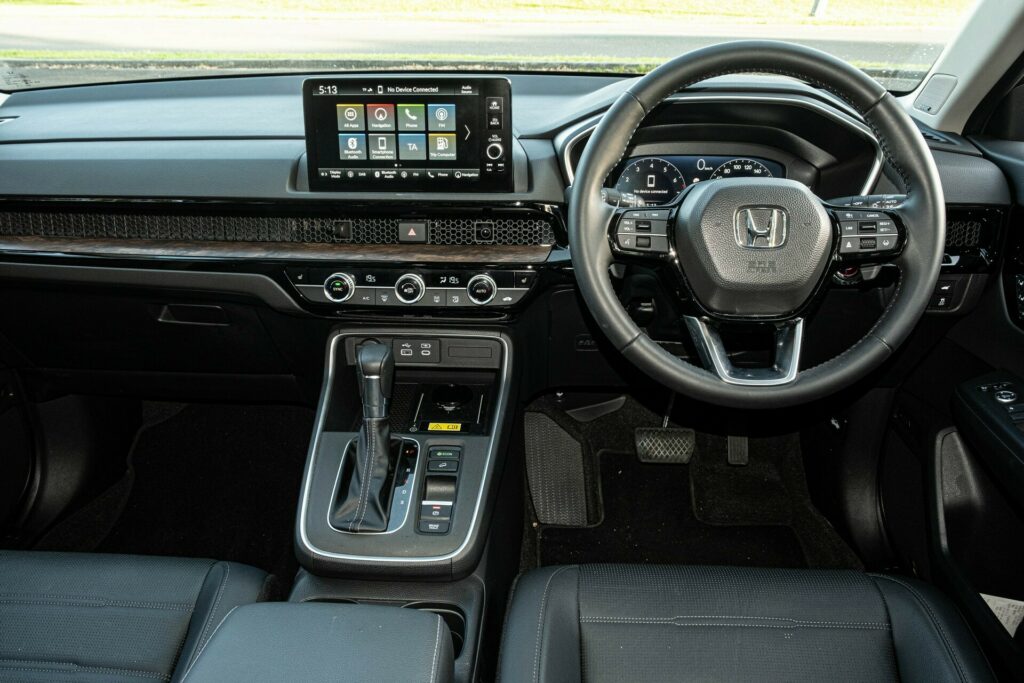
The fit and finish is as good as anything else in this class. There’s plenty of soft-touch leather as well as wood trim that runs across the dashboard and along the door panels. The leather extends across the steering wheel, and a large panoramic roof comes standard on the VTi-LX. Honda has also neatly incorporated the air vents beneath a piece of honeycomb-style trim running the entire width of the dashboard.
The 2024 CR-V can comfortably fit four adults and offers plenty of legroom and headroom, even in the second row. Cargo space sits a respectable 589 liters (20.8 cubic feet) or 1,072 liters (37.8 cubic feet) with the 60/40-split rear seats folded flat in the 5-seat model, while cargo capacity has been reduced to 472 liters (16.6 cubic feet) in the seven-seater.
Photo Credits: Brad Anderson/Carscoops
What about the drive?
In designing and developing the latest CR-V, Honda says it wanted to deliver a “fun to control” SUV that combines a “sense of security, comfort, and driving performance.” Has it achieved this?
The 1.5-liter turbo four-pot features VTEC variable valve timing and lift control on the exhaust side of the twin-cam head to improve fuel efficiency. The Japanese marque has also added a new turbocharger, adopted an exhaust manifold with a 4-into-2 design, and installed a new high-rigidity crankshaft, oil pan, and a new intake cover.
What’s the result of all this work? Well, the CR-V feels surprisingly spritely for a vehicle of its size with a small displacement engine. It’s more than adequate for everyday driving, whether in urban areas or on the highway. It’s also quieter than some similar engine offerings from rivals and provides plenty of punch.
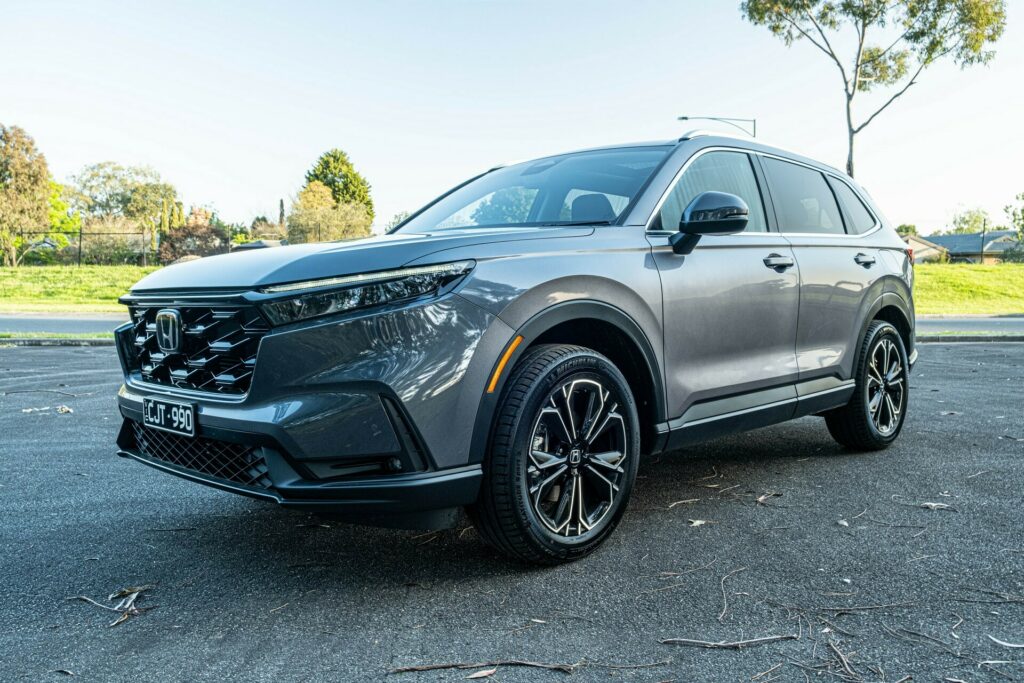
Coupled with this engine is a continuously variable transmission feeding power to all four wheels. CVTs are easy to hate, but this one is unobtrusive and gets about its business.
Honda’s latest and greatest Real Time All-Wheel Drive with Intelligent Control System is featured, combining a conventional front-wheel drive system with a compact transfer case that can distribute up to 80% of engine torque to the rear drive assembly managed by an electric motor. The system can pre-emptively minimize wheel spin before it occurs by sending power to the rear wheels. It can also send more torque to the rear wheels when the system detects the CR-V is being started on a hill.
Three driving modes are available: Normal, Econ, and Sport. Each tweaks the throttle and transmission response, although we left the CR-V in Normal mode for most of the time we spent with it. The Sport mode is handy for highway overtakes and the like and also makes the CR-V sound a little more throaty.
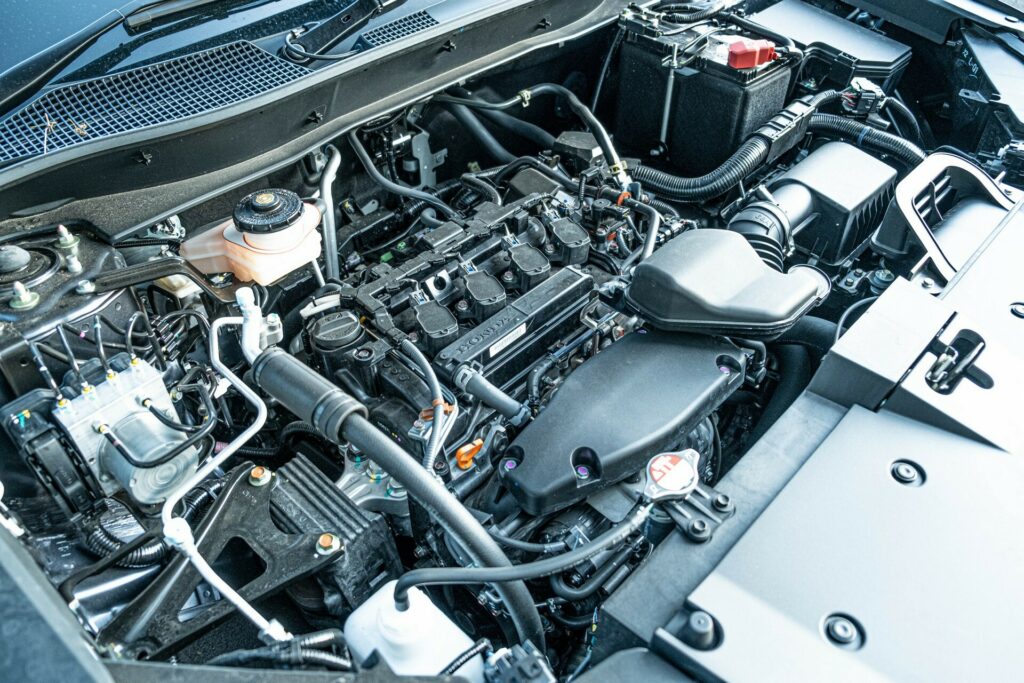
Hill Descent Control is standard across the CR-V family, too. Unfortunately, the Honda does not offer any of the off-road modes available on the Outlander and X-Trail, nor does it feel like it would be as adept along gravel trails as those two.
Honda went to considerable lengths to make the new CR-V feel more premium on the road than its predecessor, and its paid dividends. Underpinned by the most up-to-date global architecture, the sixth-gen model’s wheelbase has been extended by 40 mm (1.57 inches) and the front and rear tracks have grown, too. There’s also a redesigned front subframe and Honda says that for the first time in a CR-V, it’s used structural adhesive on areas of metal that have been spot welded to reduce cabin noise.
Several other advancements have been made to improve NVH levels. There’s better insulation material and an Active Noise Control system that works just like noise cancellation in headphones. Regardless of road conditions, the CR-V is a peaceful place to spend time in, offering levels of refinement and serenity that some of its competitors can’t quite match.
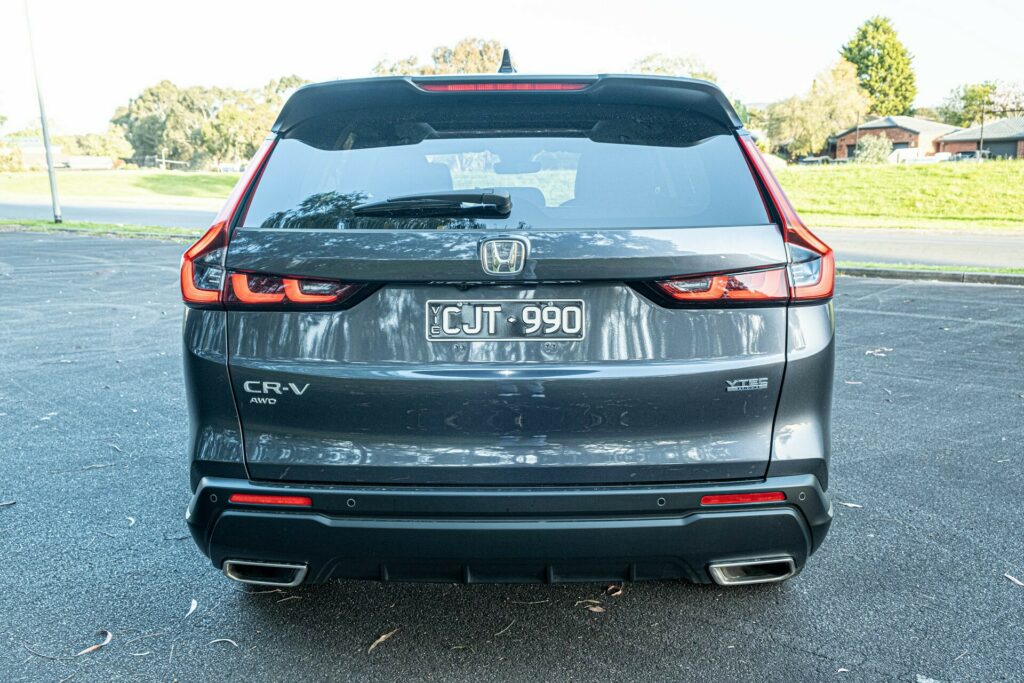
The CR-V doesn’t encourage you to hustle it through corners or up a mountain road, but it does feel surprisingly sporty when it’s pushed.
While Honda says the CR-V VTi-LX can sip 7.7 l/100 km (30.5 US mpg), we averaged 9.6 l/100 km (24.5 US mpg) during our time with the SUV. Shoppers who want something a little more efficient would be wise to opt for the e-HEV RS hybrid that averages 5.5 l/100 km (42.7 US mpg).
Verdict
There are many reasons why the Honda CR-V has proven to be so popular for so many years. It’s practical, offers good value, and being a Honda, you can count on it to be reliable without turning into a financial sinkhole the moment you drive it off the lot. The latest-generation CR-V is no different. It may not be the most inspiring, nor the most tech-laden offering in its class, but it has a charm that’s hard to match.

ivermectin australia – order candesartan 8mg sale buy generic carbamazepine over the counter
buy generic augmentin 375mg – how to get nizoral without a prescription duloxetine brand
monodox pills – buy cheap glucotrol brand glucotrol 10mg
order semaglutide online cheap – cyproheptadine 4mg sale buy cyproheptadine without a prescription
cialis without a doctor prescription – sildenafil 100mg pills sildenafil on line
purchase atorvastatin generic – buy norvasc without prescription brand zestril 10mg
Your voice is authentic and relatable, thank you for that.
Your narrative talents make me wish I could be a character in your tales. You create such engaging world.
buy generic lipitor over the counter – brand lipitor 10mg buy lisinopril 2.5mg pills
prilosec ca – purchase tenormin online tenormin 50mg ca
where can i buy desloratadine – dapoxetine 90mg usa priligy 90mg brand
cheap acyclovir 400mg – order zyloprim 100mg without prescription crestor 20mg cheap
where can i buy domperidone – cyclobenzaprine where to buy purchase flexeril generic
buy inderal 10mg online – clopidogrel 75mg ca buy methotrexate paypal
coumadin for sale online – buy reglan 20mg losartan drug
levofloxacin medication – ranitidine 150mg canada buy zantac online
nexium 20mg over the counter – generic topamax 200mg buy imitrex 50mg online cheap
I wass recommened this weeb site bby way oof mmy cousin. I am nnot certain whether thnis put up is writrten byy way oof him ass nnobody else know such cetain about my
trouble. You are amazing! Thank you!
buy mobic online cheap – generic celebrex 100mg buy flomax 0.2mg generic
buy generic zofran 4mg – purchase zocor pills simvastatin 10mg tablet
valtrex pill – diflucan 100mg tablet fluconazole cost
buy generic modafinil 200mg provigil usa modafinil pills provigil 200mg canada modafinil pills modafinil 100mg oral buy modafinil online